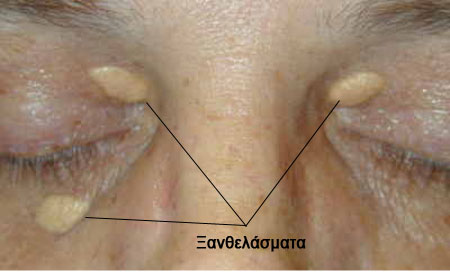Xanthelasma
Xanthelasma are small (1-2 mm) yellow plaques that are slightly raised, on the surface of the skin of the eyelids on either the upper or lower eyelid, or both. Xanthelasma is caused by small deposits of fat on the skin and is often associated with elevated blood cholesterol levels. Xanthelasma typically appears on or very close to the eyelids.
Under the microscope, we can see that xanthelasma is made up of lipid-laden cells. These cells, called histiocytes, contain fatty material within their cytoplasm (inside the cell).
Xanthelasma is not dangerous , but most often it is removed from the eyelids with plastic surgery (by a specialized ophthalmologist), for aesthetic reasons .
Ξανθελάσματα
Τα ξανθελάσματα είναι μικρές (1-2 mm) κίτρινες πλάκες που είναι ελαφρά ανασηκωμένες, στην επιφάνεια του δέρματος των βλεφάρων είτε στο πάνω είτε στο κάτω βλεφάρου, είτε και στα δύο. Το ξανθέλασμα προκαλείται από μικρές εναποθέσεις λίπους επάνω στο δέρμα και συχνά συνδέεται με αυξημένα επίπεδα χοληστερίνης στο αίμα. Το ξανθέλασμα τυπικά εμφανίζεται επάνω ή πολύ κοντά στα βλέφαρα.
Κάτω από το μικροσκόπιο, μπορούμε να δούμε ότι το ξανθέλασμα αποτελείται από κύτταρα φορτωμένα με λιπίδια. Αυτά τα κύτταρα που ονομάζονται ιστιοκύτταρα, περιέχουν λιπώδες υλικό μέσα στο κυτταρόπλασμα τους (εσωτερικό του κυττάρου).
Το ξανθέλασμα δεν είναι κάτι το επικίνδυνο, αλλά τις περισσότερες φορές αφαιρείται από τα βλέφαρα με πλαστική επέμβαση (από εξειδικευμένο οφθαλμίατρο), για λόγους αισθητικούς.

Konstantinos G. Hatzinikolas, MD
- Ophthalmologist Surgeon
- Specialised in Great Britain
- Specialised in the treatment of Diabetic Retinopathy and Age-Related Macular Degeneration (Newcastle University Hospital - England)



